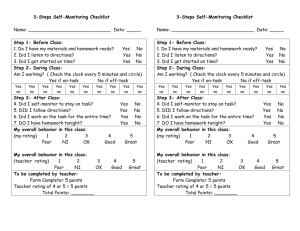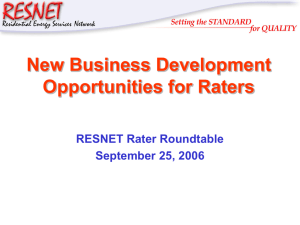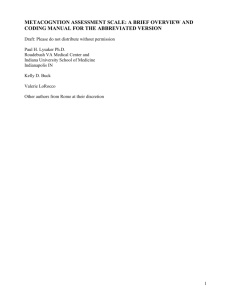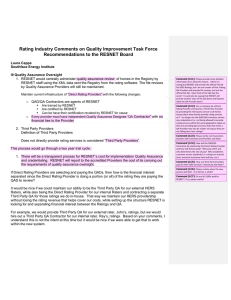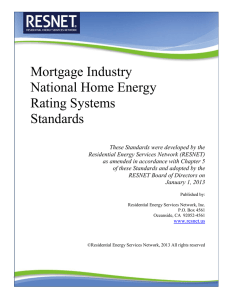RESNET Rater Test Study Guide Outline
advertisement
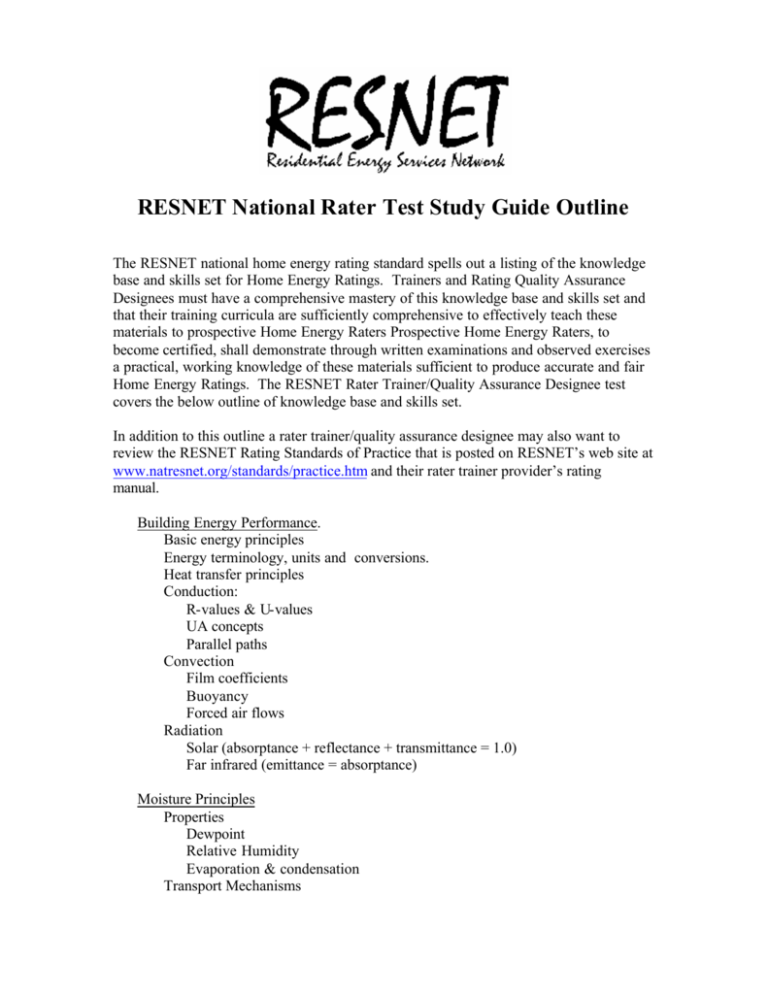
RESNET National Rater Test Study Guide Outline The RESNET national home energy rating standard spells out a listing of the knowledge base and skills set for Home Energy Ratings. Trainers and Rating Quality Assurance Designees must have a comprehensive mastery of this knowledge base and skills set and that their training curricula are sufficiently comprehensive to effectively teach these materials to prospective Home Energy Raters Prospective Home Energy Raters, to become certified, shall demonstrate through written examinations and observed exercises a practical, working knowledge of these materials sufficient to produce accurate and fair Home Energy Ratings. The RESNET Rater Trainer/Quality Assurance Designee test covers the below outline of knowledge base and skills set. In addition to this outline a rater trainer/quality assurance designee may also want to review the RESNET Rating Standards of Practice that is posted on RESNET’s web site at www.natresnet.org/standards/practice.htm and their rater trainer provider’s rating manual. Building Energy Performance. Basic energy principles Energy terminology, units and conversions. Heat transfer principles Conduction: R-values & U-values UA concepts Parallel paths Convection Film coefficients Buoyancy Forced air flows Radiation Solar (absorptance + reflectance + transmittance = 1.0) Far infrared (emittance = absorptance) Moisture Principles Properties Dewpoint Relative Humidity Evaporation & condensation Transport Mechanisms Rain and ground water Capillary action Air transported Vapor Diffusion Evaporation and condensation Impacts Indoor Air Quality (IAQ) Material and building durability Human comfort Energy use Air flow in buildings Pressure differentials and measurement techniques Mechanisms and drivers Energy and comfort implications Health & safety issues Heating, cooling, ventilation and hot water systems System types Direct- fired systems Condensing systems Heat pumps and air conditioning systems Air Source Ground Source Hydronic systems Combo systems Ductless systems Solar thermal systems Efficiency Measures of efficiency Determination of efficiency (nameplate, age-based defaults, etc.) Sizing & design Impacts on energy use Impacts on humidity control Controls Standard thermostats Programmable thermostats Multi- zone Distribution systems Duct types Restricted returns Closed interior doors Return ducts and grills Leakage Fresh air ventilation Supply, exhaust and balanced flow systems Heat exchange systems Energy/ent halpy exchange systems Exchanger efficiency, fan power and duty cycle characteristics Renewable energy systems Active and passive space heating systems Solar hot water systems Photovoltaic systems Wind generation Diagnostic testing procedures Building airtightness Multipoint pressure testing C, n, )p and R2 Air distribution system airtightness Pressure pan threshold tests Duct air leakage measurements cfm25_total cfm25_out Pressure measurements Operational (by ho me and its equipment) Imposed (by blower door, etc.) Air heat and moisture measurements Airflows Temperatures Relative humidity Identifying minimum rated features as defined in the National Home Energy Rating Technical Guideline: Identify basic home construction types; ramifications of these for energy usage. Produce a scaled and dimensioned sketch of a home. Identification of insulation defects and ability to account for them in energy analysis tool inputs. Identify and document the features of the rated home in accordance with the requirements of Section B.5. and Appendix A of the National Home Energy Rating Technical Guidelines. Identifying potential building problems Health and safety concerns Building durability issues Potential comfort problems Possible elevated energy use Rating Procedures Understanding construction documents Building drawings Specifications Field data collection (including photo documentation) Physical measureme nts Completing scaled sketches Measuring building dimensions Determining building orientations Measuring window overhang lengths and heights Determining roof slopes, gable heights, etc. Calculating gross and net areas and volumes. Energy feature documentation Energy Analysis (Software) tool data requirements Developing and using field inspection forms Organizing data entry procedures Characterizing envelope features Determining wall types Determining window and door types and characteristics Determining envelope insulation types, thickness, thermal characteristics and weighted average thermal values Determining duct system characteristics (duct types, insulation value, location with respect to the thermal and air barrier) Equipment efficiencies determination Nameplate data ARI and GAMA guides Age-based defaults In situ measurements Performance testing Envelope leakage Air distribution system leakage Local climate impacts Major US climate zones 97.5% and 2.5% design conditions Cooling and heating design trade-offs Utility prices Revenue-based pricing Reliable sources Reports Minimum reporting requirements Improvement analysis Projected and confirmed ratings Operating Procedures and Office Administration National guidelines and standards Accreditation Procedures Technical Guidelines Training & Certification Standards Understanding the Reference home and rating method Reference Home as defined in B.2 of the National Home Energy Rating Technical Guidelines (“Twin” home concept): “The reference home is the geometric twin of the rated home, configured to a standard set of thermal performance characteristics, from which the energy budget, that is the basis for comparison, is derived.” HERS Score computation using the Normalized Modified Loads Rating Method Uses of a Rating Builder assistance Cost effective building design assistance Quality assurance assistance Marketing Program qualifications EPA Energy Star Utility Other Financing advantages Energy Efficient Mortgages (EEM) Energy Improvement Mortgages (EIM) Energy Code compliance Added appraisal value Consumer education Understanding real estate, financing and economic terminology Dealing with clients Understanding the business aspects of being a energy rater Cultivating builder, banker and real estate partners. Knowing who the customer is. Providing excellent service. Ethics and disclosure





